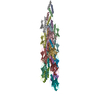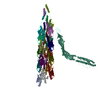+ Open data
Open data
- Basic information
Basic information
| Entry |  | ||||||||||||||||||||||||
|---|---|---|---|---|---|---|---|---|---|---|---|---|---|---|---|---|---|---|---|---|---|---|---|---|---|
| Title | Type IV pilus from Pseudomonas PAO1 strain | ||||||||||||||||||||||||
 Map data Map data | Type IV pilus from Pseudomonas PAO1 strain | ||||||||||||||||||||||||
 Sample Sample |
| ||||||||||||||||||||||||
 Keywords Keywords | Type IV pilus / T4P / PAO1 / MEMBRANE PROTEIN | ||||||||||||||||||||||||
| Function / homology |  Function and homology information Function and homology informationtype IV pilus / single-species biofilm formation on inanimate substrate / type IV pilus-dependent motility / cell adhesion involved in single-species biofilm formation / pilus / regulation of calcium-mediated signaling / host cell endoplasmic reticulum membrane / cell surface / plasma membrane / cytosol Similarity search - Function | ||||||||||||||||||||||||
| Biological species |   Pseudomonas aeruginosa PAO1 (bacteria) Pseudomonas aeruginosa PAO1 (bacteria) | ||||||||||||||||||||||||
| Method | single particle reconstruction / cryo EM / Resolution: 3.6 Å | ||||||||||||||||||||||||
 Authors Authors | Thongchol J / Zhang J / Zeng L | ||||||||||||||||||||||||
| Funding support |  United States, 7 items United States, 7 items
| ||||||||||||||||||||||||
 Citation Citation |  Journal: Science / Year: 2024 Journal: Science / Year: 2024Title: Removal of type IV pili by a small RNA virus. Authors: Jirapat Thongchol / Zihao Yu / Laith Harb / Yiruo Lin / Matthias Koch / Matthew Theodore / Utkarsh Narsaria / Joshua Shaevitz / Zemer Gitai / Yinghao Wu / Junjie Zhang / Lanying Zeng /  Abstract: The retractile type IV pilus (T4P) is important for virulence of the opportunistic human pathogen . The single-stranded RNA (ssRNA) phage PP7 binds to T4P and is brought to the cell surface through ...The retractile type IV pilus (T4P) is important for virulence of the opportunistic human pathogen . The single-stranded RNA (ssRNA) phage PP7 binds to T4P and is brought to the cell surface through pilus retraction. Using fluorescence microscopy, we discovered that PP7 detaches T4P, which impairs cell motility and restricts the pathogen's virulence. Using cryo-electron microscopy, mutagenesis, optical trapping, and Langevin dynamics simulation, we resolved the structure of PP7, T4P, and the PP7/T4P complex and showed that T4P detachment is driven by the affinity between the phage maturation protein and its bound pilin, plus the pilus retraction force and speed, and pilus bending. Pilus detachment may be widespread among other ssRNA phages and their retractile pilus systems and offers new prospects for antibacterial prophylaxis and therapeutics. | ||||||||||||||||||||||||
| History |
|
- Structure visualization
Structure visualization
| Supplemental images |
|---|
- Downloads & links
Downloads & links
-EMDB archive
| Map data |  emd_41625.map.gz emd_41625.map.gz | 88.2 MB |  EMDB map data format EMDB map data format | |
|---|---|---|---|---|
| Header (meta data) |  emd-41625-v30.xml emd-41625-v30.xml emd-41625.xml emd-41625.xml | 12.7 KB 12.7 KB | Display Display |  EMDB header EMDB header |
| FSC (resolution estimation) |  emd_41625_fsc.xml emd_41625_fsc.xml | 12 KB | Display |  FSC data file FSC data file |
| Images |  emd_41625.png emd_41625.png | 32.5 KB | ||
| Filedesc metadata |  emd-41625.cif.gz emd-41625.cif.gz | 5.4 KB | ||
| Archive directory |  http://ftp.pdbj.org/pub/emdb/structures/EMD-41625 http://ftp.pdbj.org/pub/emdb/structures/EMD-41625 ftp://ftp.pdbj.org/pub/emdb/structures/EMD-41625 ftp://ftp.pdbj.org/pub/emdb/structures/EMD-41625 | HTTPS FTP |
-Validation report
| Summary document |  emd_41625_validation.pdf.gz emd_41625_validation.pdf.gz | 548 KB | Display |  EMDB validaton report EMDB validaton report |
|---|---|---|---|---|
| Full document |  emd_41625_full_validation.pdf.gz emd_41625_full_validation.pdf.gz | 547.6 KB | Display | |
| Data in XML |  emd_41625_validation.xml.gz emd_41625_validation.xml.gz | 13.4 KB | Display | |
| Data in CIF |  emd_41625_validation.cif.gz emd_41625_validation.cif.gz | 18 KB | Display | |
| Arichive directory |  https://ftp.pdbj.org/pub/emdb/validation_reports/EMD-41625 https://ftp.pdbj.org/pub/emdb/validation_reports/EMD-41625 ftp://ftp.pdbj.org/pub/emdb/validation_reports/EMD-41625 ftp://ftp.pdbj.org/pub/emdb/validation_reports/EMD-41625 | HTTPS FTP |
-Related structure data
| Related structure data |  8tumMC  8tuwC  8tuxC C: citing same article ( M: atomic model generated by this map |
|---|---|
| Similar structure data | Similarity search - Function & homology  F&H Search F&H Search |
- Links
Links
| EMDB pages |  EMDB (EBI/PDBe) / EMDB (EBI/PDBe) /  EMDataResource EMDataResource |
|---|---|
| Related items in Molecule of the Month |
- Map
Map
| File |  Download / File: emd_41625.map.gz / Format: CCP4 / Size: 178 MB / Type: IMAGE STORED AS FLOATING POINT NUMBER (4 BYTES) Download / File: emd_41625.map.gz / Format: CCP4 / Size: 178 MB / Type: IMAGE STORED AS FLOATING POINT NUMBER (4 BYTES) | ||||||||||||||||||||||||||||||||||||
|---|---|---|---|---|---|---|---|---|---|---|---|---|---|---|---|---|---|---|---|---|---|---|---|---|---|---|---|---|---|---|---|---|---|---|---|---|---|
| Annotation | Type IV pilus from Pseudomonas PAO1 strain | ||||||||||||||||||||||||||||||||||||
| Projections & slices | Image control
Images are generated by Spider. | ||||||||||||||||||||||||||||||||||||
| Voxel size | X=Y=Z: 0.86 Å | ||||||||||||||||||||||||||||||||||||
| Density |
| ||||||||||||||||||||||||||||||||||||
| Symmetry | Space group: 1 | ||||||||||||||||||||||||||||||||||||
| Details | EMDB XML:
|
-Supplemental data
- Sample components
Sample components
-Entire : Type IV twitching pilus
| Entire | Name: Type IV twitching pilus |
|---|---|
| Components |
|
-Supramolecule #1: Type IV twitching pilus
| Supramolecule | Name: Type IV twitching pilus / type: organelle_or_cellular_component / ID: 1 / Parent: 0 / Macromolecule list: all |
|---|---|
| Source (natural) | Organism:  |
| Molecular weight | Theoretical: 240 KDa |
-Macromolecule #1: Type IV major pilin protein PilA
| Macromolecule | Name: Type IV major pilin protein PilA / type: protein_or_peptide / ID: 1 / Number of copies: 16 / Enantiomer: LEVO |
|---|---|
| Source (natural) | Organism:  Pseudomonas aeruginosa PAO1 (bacteria) / Strain: PAO1 Pseudomonas aeruginosa PAO1 (bacteria) / Strain: PAO1 |
| Molecular weight | Theoretical: 14.878889 KDa |
| Sequence | String: FTLIELMIVV AIIGILAAIA IPQYQNYVAR SEGASALATI NPLKTTVEES LSRGIAGSKI KIGTTASTAT ETYVGVEPDA NKLGVIAVA IEDSGAGDIT FTFQTGTSSP KNATKVITLN RTADGVWACK STQDPMFTPK GCDN UniProtKB: Type IV major pilin protein PilA |
-Experimental details
-Structure determination
| Method | cryo EM |
|---|---|
 Processing Processing | single particle reconstruction |
| Aggregation state | filament |
- Sample preparation
Sample preparation
| Buffer | pH: 7.4 / Component - Concentration: 1.0 x / Component - Name: PBS Details: 137 mM NaCl, 2.7 mM KCl, 8 mM Na2HPO4, and 2 mM KH2PO4, pH 7.4 |
|---|---|
| Vitrification | Cryogen name: ETHANE / Chamber humidity: 80 % / Instrument: FEI VITROBOT MARK II |
- Electron microscopy
Electron microscopy
| Microscope | FEI TITAN KRIOS |
|---|---|
| Image recording | Film or detector model: GATAN K3 (6k x 4k) / Number real images: 5085 / Average electron dose: 50.85 e/Å2 |
| Electron beam | Acceleration voltage: 300 kV / Electron source:  FIELD EMISSION GUN FIELD EMISSION GUN |
| Electron optics | C2 aperture diameter: 100.0 µm / Illumination mode: FLOOD BEAM / Imaging mode: BRIGHT FIELD / Nominal defocus max: 2.2 µm / Nominal defocus min: 1.2 µm |
| Sample stage | Specimen holder model: FEI TITAN KRIOS AUTOGRID HOLDER / Cooling holder cryogen: NITROGEN |
| Experimental equipment |  Model: Titan Krios / Image courtesy: FEI Company |
 Movie
Movie Controller
Controller









 Z (Sec.)
Z (Sec.) Y (Row.)
Y (Row.) X (Col.)
X (Col.)





















